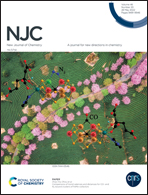Structural symmetry-breaking of a perylene diimide acceptor at the N-position for enhanced photovoltaic performance†
Abstract
The vinylene-bridged helical perylene diimide dimer (PDI2) and its derivatives have received considerable attention for application in nonfullerene organic solar cells (OSCs). Benefitting from the large natural dipole moment and the reinforced intermolecular forces, a series of asymmetrical non-fullerene acceptors (NFAs) including perylene diimide (PDI) derivatives show comparable and even-better photovoltaic performances in comparison to the symmetrical counterparts. Nevertheless, most of the asymmetrical PDI acceptors were achieved by incorporating a different functional group at the bay position. Breaking the molecular symmetry of PDI at the N position in the imide group is rarely reported. In this contribution, an asymmetrical PDI2 derivative, namely MBI-PDI2, which was constructed by the installation of a mono-benzimidazole group at one of the four imide groups, was synthesized. Using commercially purchased PM6 as an electron donor, a best power conversion efficiency (PCE) of 7.13% was achieved for the MBI-PDI2-based OSCs, which is higher than that of the parent PDI2-based ones. This result demonstrates that structural symmetry-breaking at the N position is a versatile design strategy for high-performance PDI-based NFAs.



 Please wait while we load your content...
Please wait while we load your content...